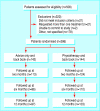Randomised controlled trial of physiotherapy compared with advice for low back pain
- PMID: 15377573
- PMCID: PMC518892
- DOI: 10.1136/bmj.38216.868808.7C
Randomised controlled trial of physiotherapy compared with advice for low back pain
Abstract
Objective: To measure the effectiveness of routine physiotherapy compared with an assessment session and advice from a physiotherapist for patients with low back pain.
Design: Pragmatic, multicentre, randomised controlled trial.
Setting: Seven British NHS physiotherapy departments.
Participants: 286 patients with low back pain of more than six weeks' duration.
Intervention: Routine physiotherapy or advice on remaining active from a physiotherapist. Both groups received an advice book.
Main outcome measures: Primary outcome was scores on the Oswestry disability index at 12 months. Secondary outcomes were scores on the Oswestry disability index (two and six months), scores on the Roland and Morris disability questionnaire and SF-36 (2, 6 and 12 months), and patient perceived benefit from treatment (2, 6, and 12 months).
Results: 200 of 286 patients (70%) provided follow up information at 12 months. Patients in the therapy group reported enhanced perceptions of benefit, but there was no evidence of a long term effect of physiotherapy in either disease specific or generic outcome measures (mean difference in change in Oswestry disability index scores at 12 months -1.0%, 95% confidence interval -3.7% to 1.6%). The most common treatments were low velocity spinal joint mobilisation techniques (72%, 104 of 144 patients) and lumbar spine mobility and abdominal strengthening exercises (94%, 136 patients).
Conclusions: Routine physiotherapy seemed to be no more effective than one session of assessment and advice from a physiotherapist.
Comment in
-
Back pain and physiotherapy.BMJ. 2004 Sep 25;329(7468):694-5. doi: 10.1136/bmj.329.7468.694. BMJ. 2004. PMID: 15388588 Free PMC article. No abstract available.
-
Physiotherapy compared with advice for low back pain: ...but at no point compared physiotherapy with chiropractic.BMJ. 2004 Dec 11;329(7479):1402-3; discussion 1403. doi: 10.1136/bmj.329.7479.1402-b. BMJ. 2004. PMID: 15591571 Free PMC article. No abstract available.
-
Physiotherapy compared with advice for low back pain: study supports concept of self management of pain..BMJ. 2004 Dec 11;329(7479):1402; discussion 1403. doi: 10.1136/bmj.329.7479.1402-a. BMJ. 2004. PMID: 15591572 Free PMC article. No abstract available.
-
Physiotherapy compared with advice for low back pain: targeting "physical factors" alone is not evidence based practice.BMJ. 2004 Dec 11;329(7479):1402; discussion 1403. doi: 10.1136/bmj.329.7479.1402. BMJ. 2004. PMID: 15591573 Free PMC article. No abstract available.
References
-
- Klaber Moffett J, Richardson G, Sheldon TA, Maynard A. Back pain. Its management and cost to society. University of York: Centre for Health Economics, NHS Centre for Reviews and dissemination, 1995. (Discussion paper No 129.)
-
- Clinical Standards Advisory Group. Epidemiology review: the epidemiology and cost of back pain. London: HMSO, 1994.
-
- Maniadakis N, Gray A. The economic burden of back pain in the UK. Pain 2000;84: 95-103. - PubMed
-
- Knight M, Stewart-Brown S, Fletcher L. Estimating health needs: the impact of a checklist of conditions and quality of life measurement on health information derived from community surveys. J Public Health Med 2001;23: 179-86. - PubMed
-
- Foster N, Thompson K, Baxter G, Allen JM. Management of non-specific low back pain by therapists in Britain and Ireland. Spine 1999;24: 1332-42. - PubMed
Publication types
MeSH terms
LinkOut - more resources
Full Text Sources
Medical
Molecular Biology Databases

